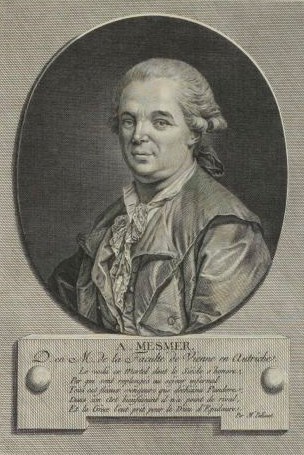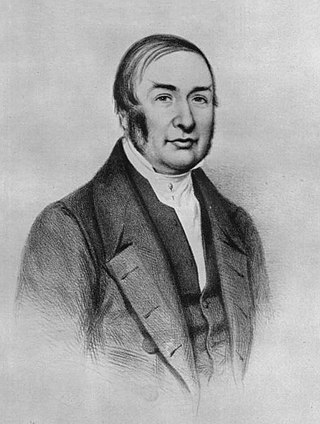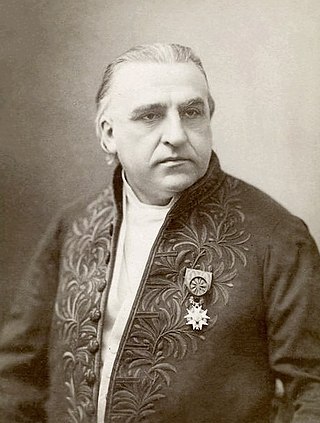
Franz Anton Mesmer was a German physician with an interest in astronomy. He theorised the existence of a natural energy transference occurring between all animated and inanimate objects; this he called "animal magnetism", sometimes later referred to as mesmerism. Mesmer's theory attracted a wide following between about 1780 and 1850, and continued to have some influence until the end of the 19th century. In 1843, the Scottish doctor James Braid proposed the term "hypnotism" for a technique derived from animal magnetism; today the word "mesmerism" generally functions as a synonym of "hypnosis". Mesmer also supported the arts, specifically music; he was on friendly terms with Haydn and Mozart.

Hypnosis is a human condition involving focused attention, reduced peripheral awareness, and an enhanced capacity to respond to suggestion.
Hypnotherapy is a type of mind–body intervention in which hypnosis is used to create a state of focused attention and increased suggestibility in the treatment of a medical or psychological disorder or concern.
Suggestibility is the quality of being inclined to accept and act on the suggestions of others. One may fill in gaps in certain memories with false information given by another when recalling a scenario or moment. Suggestibility uses cues to distort recollection: when the subject has been persistently told something about a past event, his or her memory of the event conforms to the repeated message.

James Braid was a Scottish surgeon, natural philosopher, and "gentleman scientist".
Self-hypnosis or auto-hypnosis is a form, a process, or the result of a self-induced hypnotic state.

Jean-Martin Charcot was a French neurologist and professor of anatomical pathology. He worked on hypnosis and hysteria, in particular with his hysteria patient Louise Augustine Gleizes. Charcot is known as "the founder of modern neurology", and his name has been associated with at least 15 medical eponyms, including various conditions sometimes referred to as Charcot diseases.

Molly Moon's Incredible Book of Hypnotism is a 2002 children's novel by British author Georgia Byng. It is the first instalment in the Molly Moon six-book series. Amber Entertainment and Lipsync Productions produced a film adaptation, Molly Moon and the Incredible Book of Hypnotism, which was released on April 11, 2015.
The Nancy School was a French hypnosis-centered school of psychotherapy. The origins of the thoughts were brought about by Ambroise-Auguste Liébeault in 1866, in Nancy, France. Through his publications and therapy sessions he was able to gain the attention/support from Hippolyte Bernheim: another Nancy Doctor that further evolved Liébeault's thoughts and practices to form what is known as the Nancy School.
Suggestion is the psychological process by which a person guides their own or another person's desired thoughts, feelings, and behaviors by presenting stimuli that may elicit them as reflexes instead of relying on conscious effort.
The development of concepts, beliefs and practices related to hypnosis and hypnotherapy have been documented since prehistoric to modern times.
Hypnosurgery is surgery where the patient is sedated using hypnotherapy rather than traditional anaesthetics. It is claimed that hypnosis for anaesthesia has been used since the 1840s where it was pioneered by the surgeon James Braid. There are occasional media reports of surgery being conducted under hypnosis, but since these are not carried out under controlled conditions, nothing can be concluded from them.
Stage hypnosis is hypnosis performed in front of an audience for the purposes of entertainment, usually in a theater or club. A modern stage hypnosis performance typically delivers a comedic show rather than simply a demonstration to impress an audience with powers of persuasion. Apparent effects of amnesia, mood altering and hallucination may be demonstrated in a normal presentation. Stage hypnosis performances often encourage audience members to look further into the benefits of hypnotism.
André Muller Weitzenhoffer was one of the most prolific researchers in the field of hypnosis in the latter half of the 20th century, having authored over 100 publications between 1949 and 2004. He was the recipient of several professional and academic awards, including the Distinguished Contributions to Scientific Hypnosis Award of the American Psychological Association in 1992.
The British Society of Medical Hypnotists was an organization composed of professional hypnotherapists located in London.
Sydney James Van Pelt was an Australian medical practitioner and a pioneer of modern medical hypnosis and hypnotherapy.
Animal magnetism, also known as mesmerism, is a pseudoscientific theory invented by German doctor Franz Mesmer in the 18th century. It posits the existence of an invisible natural force (Lebensmagnetismus) possessed by all living things, including humans, animals, and vegetables. He claimed that the force could have physical effects, including healing.
The National Guild of Hypnotists (NGH) is a non-profit, membership-based, international organization for professional consulting hypnotists. The organization is headquartered in Merrimack, New Hampshire. As the oldest and largest hypnotism organization in the world, NGH has approximately 20,000 members across the United States and in more than 93 countries. As of 2020, the President of the National Guild of Hypnotists is Dr. Dwight F. Damon, who is also a founding member.
Alan Gauld is a British parapsychologist, psychologist and spiritualist writer best known for his research on the history of hypnotism and mediumship.




